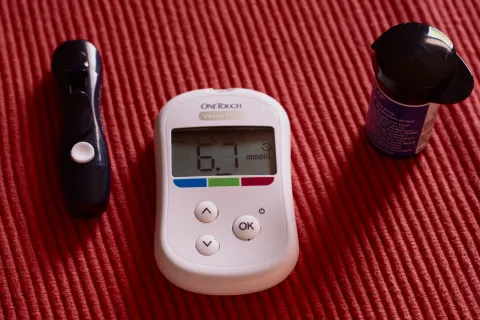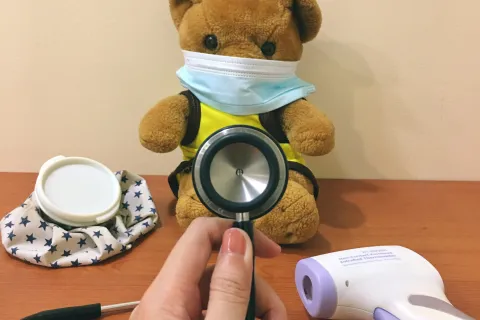Autistic Child Needs Glasses but Won't Tolerate Anything on Face
By Dr. Stephanie WeberToday’s “Got Questions?” answer is by psychologist Stephanie Weber, of the Kelly O’Leary Center for Autism Spectrum Disorders at Cincinnati Children’s Hospital Medical Center. The center and hospital are part of the Autism Speaks Autism Treatment Network (ATN).
My daughter needs glasses but doesn't like anything on her face. She won't even wear a headband. But she does let me put scrunchies and clips in her hair. Can you recommend what kind of glasses I should get for her?
Editor’s note: The following information is not meant to diagnose or treat and should not take the place of personal consultation, as appropriate, with a qualified healthcare professional and/or behavioral therapist.
Thanks for a great question on a common problem. No doubt, glasses will help your daughter in many aspects of her life. However, it can feel overwhelming to think about how you’re going to get her to wear them consistently.
If your daughter sees a behavioral therapist, I highly recommend working with her or him on this challenge. Here are some approaches I recommend.
Before buying, build tolerance
Ideally, before you invest in an expensive pair of prescription glasses, you want to start building her tolerance – step by step – with a practice pair.
First, it’s important to prepare yourself mentally to be patient with this process. We’re going to take this slowly. It might take weeks, even months. It’ll be worth it.
Once you’re mentally prepared to take it gradually, I suggest picking up a pair of inexpensive sunglasses or reading glasses and take the lenses out.
Invite your daughter to help pick them out so she feels part of the process. In particular, I recommend paying attention to her preferences for the weight of the glasses and whether they have nose pads. Importantly, try to make the practice glasses as similar to her future “real” glasses as possible.
Have rewards ready
Next, you’ll want to identify some personal motivators. What rewards work best for your daughter?
When working on a sensory issue, it can help to have a sensory reward. For example, does your daughter enjoy a firm hug? Playing in a bin of sand or bowl of water?
It’s fine to use small prizes or stickers. If it works for your child, I recommend alternating such prizes with the “reward” of praise and encouragement.
Whatever the rewards you’ve selected, have them readily available for each practice session.
Daily practice: short and focused
I strongly recommend, short and targeted practice sessions. Let’s say 5 to 15 minutes depending on her tolerance. These sessions need to be become part of her daily schedule – though it’s okay to take the occasional day off.
At first, it may help to hold these practice sessions at the same general time during the day. You know when your daughter’s at her best. Perhaps right after school, after dinner or before bed. Try to be consistent. Also make sure you leave enough time so your child does not get out of practicing by delaying.
But also remember that the goal is to get her used to wearing them all the time. So after a while, start varying the time of the practice sessions throughout the day.
I recommend having a timer at hand to help your daughter can see how long each practice session will be. I likewise recommend finding a quiet place free of distractions.
What can she tolerate?
Next, explore what your daughter can currently tolerate. It may be holding the glasses in her hand. Would she be willing to touch the glasses to her cheek? Perhaps she doesn’t even want to look at the glasses. If that’s the case, you might start by having her sit at a table with the glasses near her.
Remember, you want to set her up for success. So start wherever she’s comfortable and set the timer – even if it’s for just 5 seconds. Then reward her for her cooperation, and move on to 10 seconds.
Building momentum
You want to build momentum toward your goal. So take the scenario where your daughter is willing to sit at a table with the glasses across from her. You can increase the length of time she sits near them – or you can move the glasses closer to her. As she becomes more tolerant, you might try doing both. Each incremental step earns praise and/or a small prize.
Next, you might work on the goal of her touching the glasses five times. Then ten times. Seem silly? Great. The two of you can giggle and have fun with it. Next, have her hold the glasses for 10 seconds. Then, increase the time. You get the idea.
I suggest using patience and judgment in how far and fast you advance with each session. For instance, the next step might be for you to ask her to touch the glasses to her arm. Or maybe you sense that she’s ready to touch the glasses to her cheek or her nose. You might start with 5 seconds, then 10 seconds – and so on.
Use the same plan for helping your daughter place the glasses on her face… 5 seconds, 10 seconds, etc. Once your daughter can tolerate 2 minutes, the next goal is to have her wear the glasses at different times throughout the day and while completing various tasks or activities.
Continue to build on your daughter’s successes with positive reinforcement. But don’t let the reinforcement take over the practice session. Remember, you don’t have to provide a reward every time. Praise can be enough sometimes. In fact, I think it’s better if your daughter doesn’t expect a reward every single time she, say, touches the glasses to her face. Again, use your understanding of your daughter to figure out how much or little reinforcement she needs.
The reward of seeing clearly
The ultimate goal, of course, is to get your daughter to slip those glasses onto her face and enjoy looking at the world in a new focused light! So consider playing a “can you see this?” game to help her appreciate the wonder of seeing clearly?
Using visual supports
Visual supports can be wonderful for helping a child with autism understand expectations and build skills. For example, you might use a “First/Then” visual such as the example at right. In the “first” column, your visual could show a picture of the glasses. The “then” column would have a picture of the reward – be it a hug, bin of sand or sticker.
From new skill to routine
When you feel your child is ready to wear the glasses more often, have her practice wearing them to the grocery store or while reading a book (depending on whether they are distance or reading glasses).
This activity-specific goal provides her with a clear end time when she can take them off. But it represents a big step forward because the length of time is based on the activity, not your timer. As with any skill, repetition and practice will help make wearing glasses an everyday part of your daughter’s life.
Thanks again for your question.









